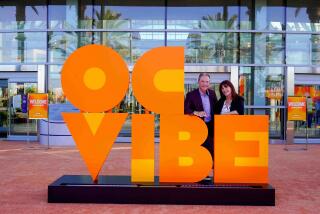Review: Brands, symbols and emblems in Gajin Fujita’s paintings at L.A. Louver
Ten years ago, billboards across Southern California proclaimed that the baseball team then known as the Anaheim Angels had become the Los Angeles Angels. Fans got mad.
Long-standing lovers of the Anaheim Angels felt betrayed. Die-hard Dodgers supporters felt that their turf had been violated. Less passionate observers saw the name change as a corporate maneuver to grab a larger market share.
After a four-year legal battle, the Los Angeles Angels of Anaheim came into being. The geographically illogical moniker seems to have pleased no one but the lawyers.
Similar issues — about power and loyalty, identity and history, money and love — unfold in Gajin Fujita’s 13 magnificent paintings at L.A. Louver. Made over the past four years, often with a little help from his friends, Fujita’s stunning stews of graffiti and gold leaf bring impressive complexity to the heroic quest to find meaning in a world otherwise inhospitable to individuals, strong-willed and otherwise.
All of Fujita’s paintings in “Warriors, Ghosts and Ancient Gods of the Pacific” make a hash of brands, mixing and mashing symbols and emblems as the 42-year-old artist plays fast and loose — and very purposefully — with history, geography and authority.
In Fujita’s pictures, sword-wielding samurai, decked out in Dodgers blue and Angels red — as well as Raiders black and a rainbow of other colors — make a mess of expectations and allegiances. Fantasy and reality rub shoulders as wild boar and goldfish embody virtues that cannot be owned or controlled, much less trademarked.
The same goes for the mythological figures Fujita portrays. Deities and demons battle bravely and shamelessly. The distinction between honor and subterfuge often gets lost in the fog of it all.
Ukiyo-e woodblock prints by such 18th- and 19th-century masters as Nishimura Shigenaga, Utagawa Kokunimasa and Utagawa Kunisada form the basis of Fujita’s compositions, which, like palimpsests, consist of overlapping styles, techniques and images, as well as colors, textures and messages. It’s a mongrel cocktail of wickedly generative influences that includes Edo painting, shunga printmaking, Kabuki theater, pop graphics, image-and-text Conceptualism, East L.A. gang writing and wild-style graffiti.
Amid the chaos, art emerges as the big winner. It provides a slice of space in which Fujita and his band of mavericks, malcontents and misfits strut their stuff so boldly and beautifully that visitors can’t help but want to get in on the action.
L.A. Louver, 45 N. Venice Blvd., Venice, (310) 822-4955, through July 2. Closed Saturdays and Sundays. www.lalouver.com
More to Read
The biggest entertainment stories
Get our big stories about Hollywood, film, television, music, arts, culture and more right in your inbox as soon as they publish.
You may occasionally receive promotional content from the Los Angeles Times.










